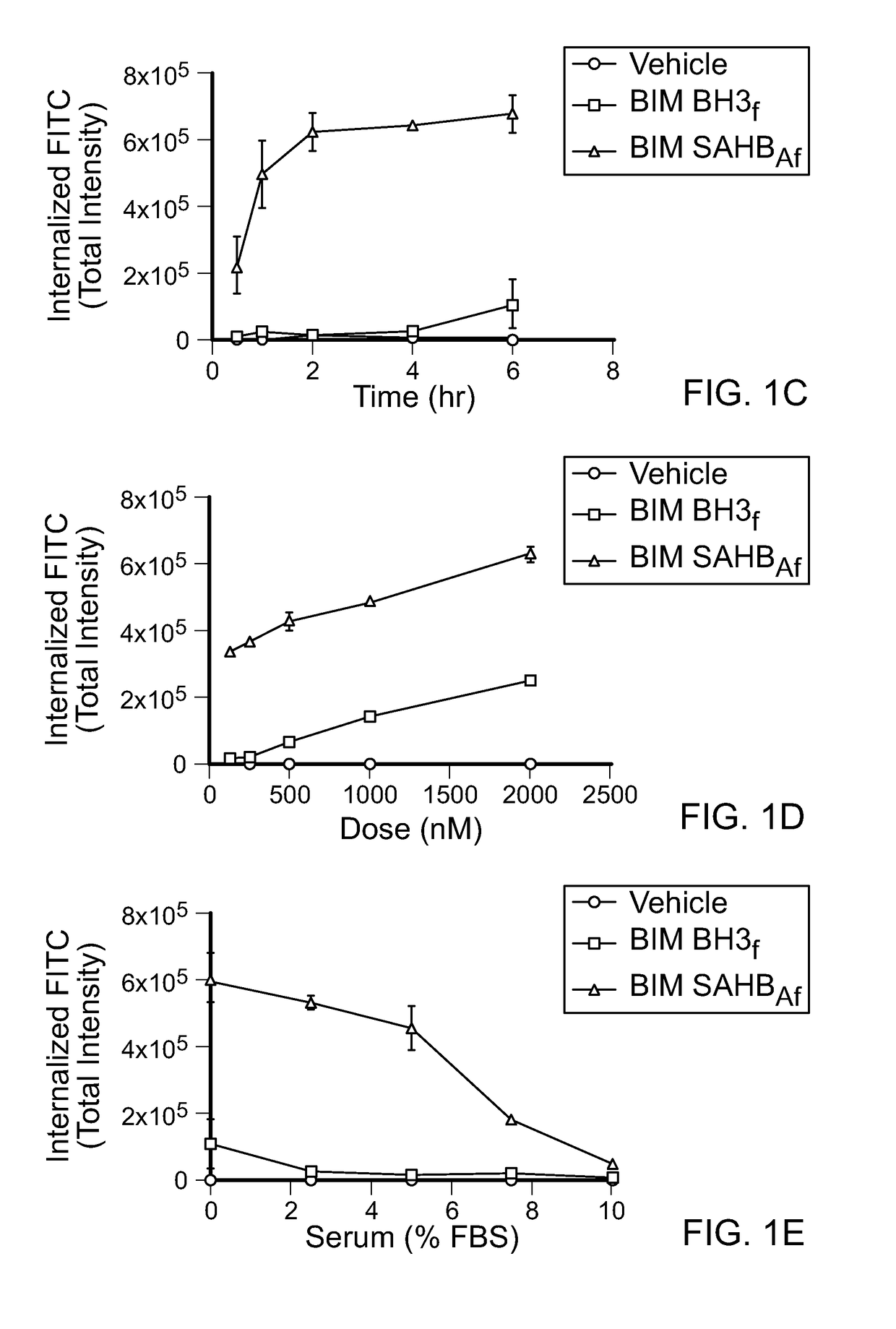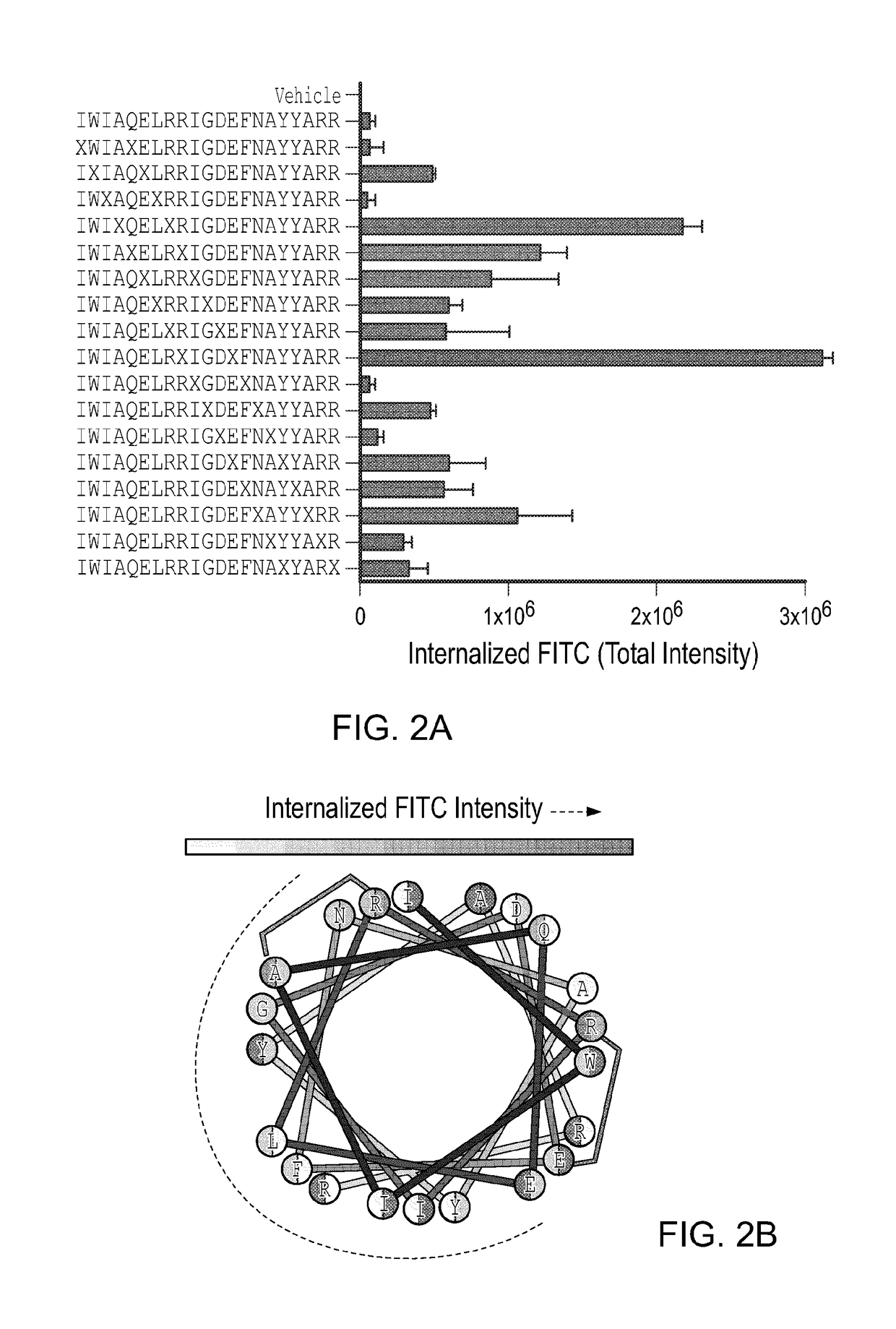Method for generating cell-penetrating stapled peptides that lack nonspecific membrane-lytic properties for therapeutic targeting
a peptide, non-specific technology, applied in the direction of peptides, peptide/protein ingredients, instruments, etc., can solve the problems of inability to definitively know the criteria for generating cell-penetrant peptide analogs, inability to accurately identify and/or optimize promising peptides, and inability to achieve optimal staples. , to achieve the effect of minimizing non-specific cell membrane lytic activity, reducing the propensity for cell uptake, and rapid determination
- Summary
- Abstract
- Description
- Claims
- Application Information
AI Technical Summary
Benefits of technology
Problems solved by technology
Method used
Image
Examples
example 1
and Methods
Stapled Peptide Synthesis and Characterization
[0261]All hydrocarbon-stapled peptides were synthesized, derivatized at the N-terminus with FITC-βAla or acetyl, and purified to >95% homogeneity by LC / MS using methods known in the art and as previously described34. Acetylated peptides were dissolved in 10% (vol / vol) acetonitrile in water for circular dichroism analyses, performed on an Aviv Biomedical spectrophotometer using methods known in the art and as previously described34.
ImageXpress Microscopy Analysis
[0262]For high-content fluorescence microscopy analysis, the indicated cell lines were plated in black, clear bottom plates overnight at a density of 2×104 cells per well in DMEM supplemented with 10% (vol / vol) FBS, 1% penicillin / streptomycin, and 1% glutamine. The following day, cells were treated with 0.5 μM FITC-labeled peptides or the equivalent amount of vehicle (0.1% DMSO) for 4 h in serum-free DMEM, and then stained with Hoechst 33342 and CellMask Deep Red (CMDR,...
example 2
nt and Validation of a High-Throughput / High-Stringency Microscopy Assay for Stapled Peptide Internalization
[0271]High-content epifluorescence microscopy and the ImageXpress Micro (IXM) Widefield High Content Analysis System were used to develop a rigorous quantitation platform for measuring cellular uptake of stapled peptides derivatized at the N-terminus with a FITC fluorophore. Custom Module Editor was used to create a custom module (CM) for analysis based on the following principles: (1) define cellular uptake in mouse embryonic fibroblasts (MEFs) based on visualizing cellular and nuclear boundaries using Hoechst 33342 and CellMask Deep Red (CMDR), respectively, thereby excluding extracellular aggregates and autofluorescent debris (FIG. 1A), (2) contract the resultant cellular mask by a defined pixel boundary to avoid quantitation of extracellular, membrane-adherent peptide, (3) exclude FITC signal outliers that reflect out-of-focus fluorescence, (4) acquire images for analysis a...
example 3
nts of Cellular Uptake for a Staple Scanning Library of BIM BH3
[0274]When designing stapled peptides for biochemical and biological studies, one of the first questions to address is where to install the staple. Here, a library of stapled BIM BH3 peptides was generated by performing a “staple scan” that sequentially places the staple along the length of the template peptide, yielding 17 i, i+4 stapled peptides. Cellular uptake of the FITC-derivatized stapled peptides was monitored by IXM using the previously described CM. Importantly, of the cellular fluorescent dyes measured in the microscopy assay (i.e., Hoechst, CMDR, FITC), only the FITC intensity varied with stapled peptide composition (FIG. 12). Strikingly, our prototype BIM SAHBA1 peptide that bears a staple flanking IGD emerged as the clear winner (TIFI>3.0×106), with four additional constructs containing staples flanking QEL, ELR, AYY, and LRR also demonstrating notable uptake at TIFIs of 2.16×106, 1.21×106, 1.07×106, and 0....
PUM
| Property | Measurement | Unit |
|---|---|---|
| pH | aaaaa | aaaaa |
| pH | aaaaa | aaaaa |
| pH | aaaaa | aaaaa |
Abstract
Description
Claims
Application Information
 Login to View More
Login to View More - R&D
- Intellectual Property
- Life Sciences
- Materials
- Tech Scout
- Unparalleled Data Quality
- Higher Quality Content
- 60% Fewer Hallucinations
Browse by: Latest US Patents, China's latest patents, Technical Efficacy Thesaurus, Application Domain, Technology Topic, Popular Technical Reports.
© 2025 PatSnap. All rights reserved.Legal|Privacy policy|Modern Slavery Act Transparency Statement|Sitemap|About US| Contact US: help@patsnap.com



